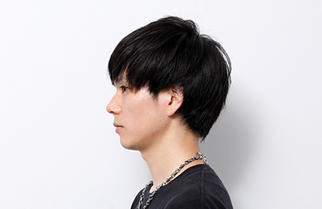
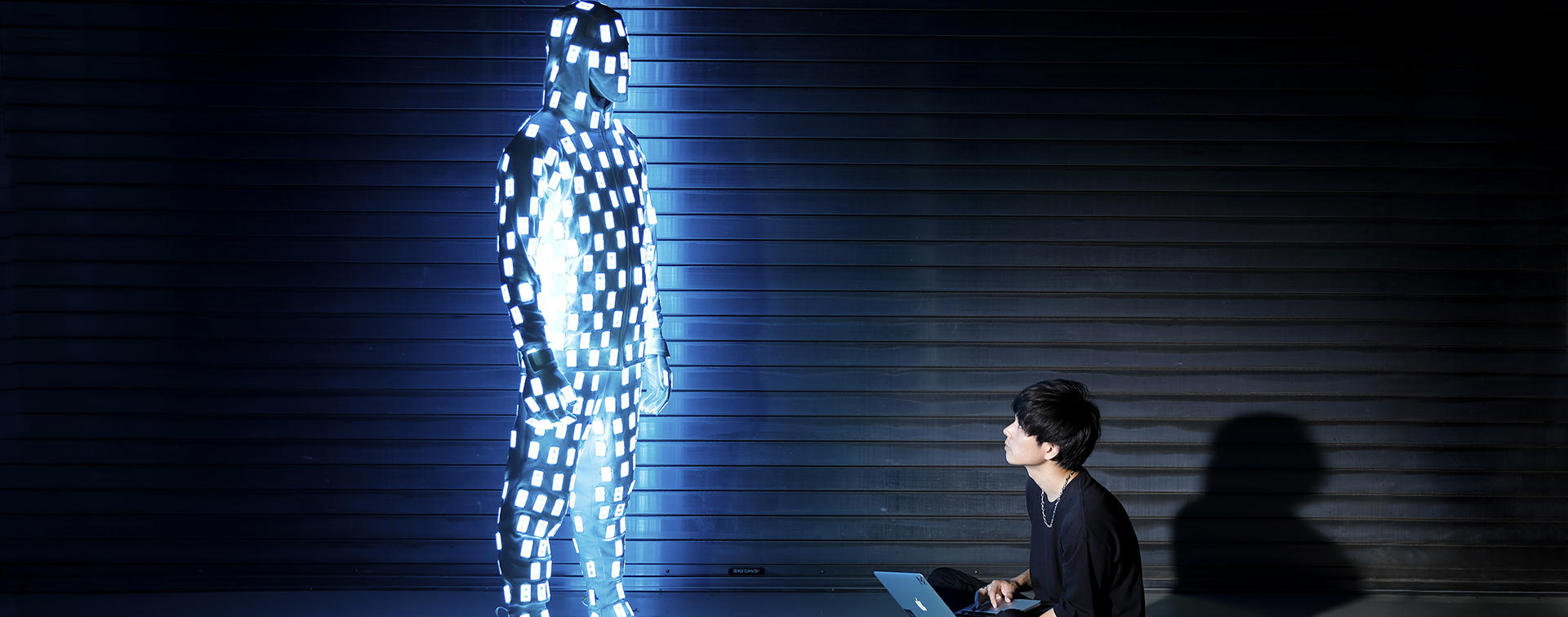

Creating a nightscape with a live, street feeling
Entertainment in the streets that blend lights with people's movements
Minoru Fujimoto is the designer of the lighted costumes worn by SAMURIZE from EXILE TRIBE and is known for his works that combine wearable computing with dance performances. The 34-year-old Super Creator has created a new genre of physical expression using lights which he calls "lighting choreography." Fujimoto told us nonchalantly, "I want to make things that nobody else in the world can come up with". We asked Fujimoto, whom people call "LED professor", about how he got started, and about the future of performances that feature lights. We also asked him about his ideas for entertainment staged in Roppongi.
My starting point was an electrifying encounter with dance
I'm 34 now; about 20 years ago, when I was in my teens, there was a bit of a boom in dance. A dance studio opened in the Kansai area, and I started learning dance. When I was a high school student, I went to a dance battle event for the first time in my life. The dancing I saw there was incredibly cool. It was electrifying.
The moment I entered the hall, there was a big booming noise and in the middle of the pitch-dark space, a competition was taking place, with the dancers facing each other. It was a scene that I cannot forget even now; it had a bigger impact on me than a baseball game or a concert, or any other event I'd been to before. From that point on, I fell headlong into the world of street dance. I stopped watching television. I wanted to concentrate on dancing, so I canceled my Internet contract during the four years at college.
The electrifying experience I had when I first saw the dance battle event, and the days I spent dancing have led to what I am doing now. Technological systems for dance performances are often created from the point of view of the developer. In many cases, the performances are simply demonstrations that showcase the technology. It's as if they're saying, "This is capable of recognizing these movements. Amazing, isn't it?" I was never impressed by those things. What I want to do is to create a system from the performer's perspective; I want to fulfill the wishes of the performer to be a certain way or to do certain things. That has been my strong desire from the very beginning.
Thinking about creating things that only I can make
Eight years ago, when I first showed my work at Ars Electronica, the maximum number of LED lights that could be fastened on a performer was 200. Now there are 9,000 lights on one costume. The size and efficiency of the devices have evolved, and the number of lights that can be controlled wirelessly in real time has increased nearly 50 times.
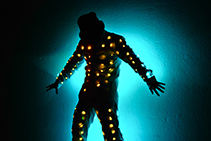
Ars Electronica
At Ars Electronica 2010, Fujimoto performed a dance wearing lights. An application software was used which could easily control the patterns of the lights in line with the music. Fujimoto says the performance was his starting point of "lighting choreography."
There's clearly been an advance in technology, but the number of LED lights isn't what really matters. What's important is that there are now more ways for performers to use the lights. But even with great technology, I would not use anything that doesn't make the dance look cool. That is my rule and my philosophy. Whether it's new or cutting-edge, I will not use technology that restricts how people move.
Because I'm not a genius engineer, I'm constantly aware of the significance of making my own original things. I want to make things that nobody else in the world can come up with. Instead of having people simply wear lighted clothing, I want to expand the possibilities of performance by using lights. My hope is that this new genre in dance called "lighting choreography" - which syncs lights, sounds and movements - will become widely accepted. "Lighting choreography" is a term I coined; I think the concept itself was new at the time and I've been responsible for developing all the necessary hardware and software. I've written the computer programs and undertaken the choreography. I'm proud of having done these things that only I could have done.
"Lighting choreography" - a new form of entertainment
Recently, I've received awards in digital art and interactive art, and opportunities have grown for lighting choreography to be seen as a form of art. But I personally feel that what I'm basically doing is to create entertainment, rooted in engineering and street dance. I'm glad that people regard it as art, but I personally have no intention of creating art.
The difficult thing about creating works is that there is no standard. Rules have not been established in this genre yet. There are no rules about how lights should be used for human movements. Motion graphics and projection mapping are established forms of digital entertainment; those genres are about showing finished movies on unmoving objects. However, no studies have yet been made on the subject of how things appear when moving lights are combined with moving things, and there is no method of analysis. With a movie, you can replay what you have made and you can imagine how the viewer will feel when watching it, but lighting choreography is the combination of movements, and there is also the movement of the viewer's eyes, and so to put it bluntly, it's difficult to grasp all the factors involved.
I make my works by first creating about 50 different kinds of "hypothetical" movies. I then go through a sifting process many times, picking those which are interesting and discarding those which are not. I connect the interesting sequences until I think "This is perfect!", and then I refine the work about five times, adding the finishing touches. There are times when I have to change 1 percent of the work which compels me to redo the remaining 99 percent. Despite the long hours of work, only about 10 to 20 percent of the original plans are actually used. It's hard, but the effort behind the work is not something that concerns the viewer.
Studying the relationship between lights and the physical body
About two years ago, I made panels showing images that can be worn on the body - that was an evolvement in expression. The panels have been placed on the chest part of all the costumes worn by "SAMURIZE from EXILE TRIBE". That was a big advance. Until then, I'd sought expression by using LED lights as dots and lines, but now I have to think about the additional factor of "surface" and about the relationship between images and physical movement. I used to think about displays in two-dimensional terms, but now I need to think about how displays will look when they are moving three-dimensionally. I had felt that I had done everything I wanted to do, but last year, I started "Quantified Dancer" where digital figures are shown with human movements; this project has brought me new challenges to tackle.
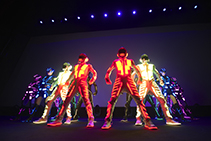
SAMURIZE from EXILE TRIBE
A performing group led by EXHILE HIRO. The group is made up of talented dancers who perform using LED lights. Fujimoto and his company mplusplus are in charge of designing the LED lights, the software and hardware, and programming the lights for the performances. The group has performed at events such as Cannes Lions International Festival of Creativity 2018 and NHK Red & White Year-end Song Festival.
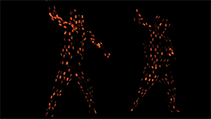
Quantified Dancer
A dance project where digital numbers are shown on dancing performers. The newest dance uses 9,000 LED lights to show a total of 450 digital numbers.

The project began after I encountered a work by Tatsuo Miyajima-san, the contemporary artist. Until then, I had been thinking of the digital elements in my works in terms of single pixels. I'd believed that I could only express myself by changing the color and movement of a single LED light or a single pixel. But when I saw Miyajima-san's "7 Seg Led" in an art museum, I was moved and thought, "If I treated a number as one pixel or one unit, maybe I will be able to create very different forms of physical expression."
I sent an email to Miyajima-san, telling him that his work had moved me and that I would like to create a dance based on "7 Seg LED". To my delight, Miyajima-san replied that the seven- segment LED display was not his creation and that I was free to make what I like. So I started thinking about the dance, but it was difficult. To be honest, I am still far from being satisfied. New problems have presented themselves such as the need to consider the increase and decrease of numbers and the discrete value, and I am being forced to think once more about the relationship between the human body and movement.
The impact of a live performance
The thing about my works is that they're neither interesting nor fun when seen on video. The performances just don't look good on video. (laughs) When 50 people wearing 9,000 LED lights start moving in front of you, it's so shocking that you feel you've come to another planet, but on video, it's not impressive at all. I think it's a pity that the videos don't capture the magic, but my starting point and my values are in the live feeling and the street feeling of a performance. I believe my strong point lies in the ability to convey those feelings.
I think what people create depend on what kind of things moved them. For instance, people who seek to become filmmakers must have had the experience of being moved by movies. For me, the experience of seeing a dance performance with my own eyes for the first time has been unforgettable, and that is why I have become a lighting choreographer. I feel that anything that does not contribute to the appeal of dance should be discarded.
There are things which I can do, but which I don't include in my works. In my college days, I tried out all the new technology like image processing and sensors, but I decided that I would cast aside things that could be dealt better by other people. What remained vital for me was the raw impact of seeing a live performance. The reason that I don't use robots in my works is because it's easier to have humans move. It would take years to make robots that move like humans; we're still at a stage where humans are better than robots in quickly responding to instructions to move in a certain way.
Something in the future that will exceed human movement
I don't know when it will happen, but I feel that in the not-too-far-off future - probably within my lifetime - things will be made whose movements will exceed those of humans. It seems that current research is aimed at making robots that can do what people do, but in the future, there will probably be research to equip robots with capabilities that exceed those of humans. I wish to be able to choreograph properly for such robots when they are developed. There is no telling what these robots may be - they may not even be robots but organic things; perhaps they will be larger than people and move faster and more smoothly, but whatever they are, I'm sure they will lead to new forms of expression.
A project that is related to such future development is the three-meter robot arm "Robotic Choreographer." The robot arm rotates five times per second. Words and videos cannot convey how amazing it is. When you see it moving in front of your eyes, it's really scary. If its rapid movements become smooth, it will completely triumph over humans. In my mind's eye, I can see this three-meter robot arm dancing hard. When I declared that I wanted to make such a dancing arm because no such thing exists yet, I was given the opportunity to do it as a government-funded research project. It has taken about a year to make the first model, but I think the pace of development is quite fast. It's marvelous that the government is offering funds for something that nobody has even seen yet. Japan is not a bad country! (laughs) We will continue pushing our development forward.
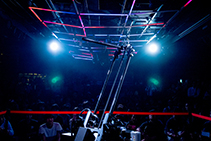
Robotic Choreographer
A project to make a robot arm for the specific purpose of performing. It is the world's first such project and aims to make a "performer" that is bigger and faster than humans. About 3 meters long, it has two axes which can rotate infinitely, and an upper arm which can rotate a maximum of five times a second. IPA (Information Technology Promotion Agency) chose the project as the second innovative IoT project that it would support.
Photo by yoshikazu inoue

Giving movement to things that are normally still
A personal theme that I'm currently working on is to give movement to still things. Since my job is choreography, I watch about 70 stages and live performances in a year, and I began to wonder why the stage doesn't move. Because the stage props and lighting are fixed, the staging is restricted from becoming organic. I talked about this to the stage director of Cirque Du Soleil, and learnt that the concept at Cirque Du Soleil is to turn flat surfaces three-dimensional by creating shapes. I decided that I would use technology to move things three-dimensionally and organically. The work "MOVINGHEADZ" is based on this concept, with people walking about wearing moving lights on their bodies. The performers walk in the venue, gathering at times and dispersing at times. I felt that instead of installing 200 lights on the ceiling, there would be more possibilities for expression to have 200 people walking with lights.
As for the things that can be done in Roppongi, I think it would be fun to have entertainment consisting of moving lights and moving people.
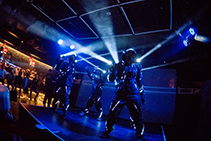
MOVINGHEADZ
A "wearable performance system" where performers carry small moving lights on their bodies. Fujimoto said he developed the system after wondering what kind of choreography would become possible if the lights that are normally installed on the stage could move on legs.
photo by yoshikazu inoue
When I come to Roppongi, it's usually to visit the art museums, and I think beforehand about how I will spend the day. I contemplate where I will go to first, and where I will eat and what I will see. If I were in Barcelona for example, I would get on the bus at one point to go from one place to another; in other cities, too, it would probably be necessary to use public transport, but in Roppongi, once you get here, there's no need to use public transport because you can walk around. You can spend the whole day here by going to and from the two huge facilities of Tokyo Midtown and Roppongi Hills. I think one of the big characteristics here is the Mori Tower at Roppongi Hills; from the top of the high-rise building you can enjoy the view of the area.
The characteristics of Roppongi are that people are walking and don't use public transport, and that people can watch the view from a high place. How about having a performance here that incorporates those two characteristics?
A night event to make the streets of Roppongi come alive
Every year, Roppongi Art Night apparently draws 700,000 people. An idea I have is to place 700,000 lighting devices at Roppongi station so that each person coming to the event can wear a light. All these people wearing lighting devices will be walking around the venue of Roppongi Art Night and in the streets. This "performance" would be completed when people in the observatory at Mori Tower look down and see them; that would be a form of entertainment using people's movements and lights and the whole area of Roppongi.
Often, at concerts held in stadiums, they hand out pen lights for people to hold and the lights look lovely. And I think there have been projects in the past where letters were written using lights on buildings, but the point about the project I have in mind is that it is a performance using moving lights. With current technology, you can identify which lights are where, and it's possible to move them. Staging could be done by taking into account where each light is located; the people wearing the lights will be the performers, and the people watching from above will be the stage directors.
Perhaps it's taken for granted that there are high-rise buildings in Roppongi, but there are not many places where you can look down from above; I think that the distance afforded from such heights enhance the experience of seeing dynamic movements.Since it would be a live event that could only happen here at a certain time, the experience would have impact. Instead of the usual nightscape, people will be seeing a nightscape with active movement.
I don't think the budget for such an event would be infeasible. It might be difficult to undertake the project on a one-year basis, but for instance, you could draw up a plan where you spend 300 million yen for the lighting devices in the first year, and reduce the budget to 50 million yen in the second year. Would a budget of 300 million yen be too big? But I'm sure the scene that will unfold will be one that nobody has seen before.
Editor's thoughts
After the interview, Fujimoto-san set off in the direction of Roppongi station, and as we saw him off, I thought how easy it is to say things, but how difficult it is to implement them. Fujimoto-san's aim is to create a new dance genre utilizing wearable computing. I am sure Fujimoto-san has a lot of mental and physical stamina that enables him to deal with huge loads of work, and that he also has a remarkable perseverance - never giving up. In person, however, Fujimoto-san was surprisingly easygoing, and talked so enthusiastically about his endeavors. I wonder what his imagination will lead to next. I look forward to seeing his new forms of innovative expression. (text tami okano)




